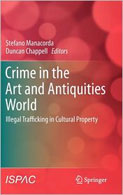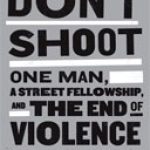Crime in the Art and Antiquities World: Illegal Trafficking
in Cultural Property

Author: Stefano Manacorda and Duncan Chappell (editors)
Publisher: New York: Springer, 2011. 453p.
Reviewer: Gisela Bichler | March 2012
At first glance, some criminologists might make the mistake of thinking that crime affecting cultural property is an arcane topic: they could not be farther from the truth. Much can be learned about illicit trade when we widen our analytic lens. A significant body of criminology is concerned with black market materials (i.e., heroin and cocaine, human trafficking, child prostitution) where all market stages of a commodity chain generally involve illegal activity. Albeit important, this fixation on illegal goods does little to inform about the vast volume of trade occurring in what has been termed the grey market. Studies of grey markets stand to offer greater insight into the precursors, mechanisms, and situations that allow illicit transnational markets to thrive, than can be derived from an exclusive focus on black markets.
A central feature of grey markets is the role legitimate actors, organizations, and situations play in fusing illegal and legal trade. With this interlock in mind, Manacorda and Chappell (2012) assemble in Crime in the Art and Antiquities World: Illegal trafficking in Cultural Property, contributions from 11 leading scholars and practitioners. While their collective efforts are aimed at halting the illicit trade in all cultural property, it should be noted that most authors included in this volume are prominent in the discourse on looted antiquities. Though much of the material presented in this volume appears elsewhere, many authors seized the opportunity to synthesize a body of their work, resulting in a series of effective, streamlined arguments. Readers interested in the extended, uncut versions can track down referenced documents.
Uniting these chapters is a call to adopt a market reduction approach (MRA) which involves strengthening official regulatory systems and fostering a reorientation of market professionals toward more effective self-governance. Collectively, these chapters summarize contemporary arguments highlighting system vulnerabilities and the role played by key actors whose ability to reach into both legal and illicit trade result in the greying or laundering of illicit goods. Merging the arguments presented, a market reduction approach would entail removing system vulnerabilities by:
- invoking strategies to reduce consumer demand for illegal products and services;
- developing and augmenting current initiatives aimed at increasing self-awareness of illicit activity by facilitators, such as accountants and lawyers, and increasing the effort required to complete illicit transactions;
- strengthening anti-laundering apparatus so as to restrict the use of licit tools used for illegal means;
- removing policy and legal asymmetries between jurisdictions to harmonize regulatory efforts and improve investigatory effectiveness; and,
- reducing the demand for vulnerable goods by expanding programs aimed at enhancing public awareness and education among the general public and market professionals.
Though pervasive, this general theme does not dominate the discussion presented by each author. All contributors offer unique insight into the nature of illicit trade in grey markets.
The chapters are somewhat oddly sorted into three sections. First, a series of chapters follow the editors introductory comments, that taken together, offer an overview of the present international legal landscape, acquaint the reader with criminological arguments aimed at explaining why this market is vulnerable to illicit trade, and offer policy recommendations. Stefano Manacorda succinctly reviews the weaknesses and limitations of the international juridical framework designed to combat illicit trafficking of cultural property. Nikos Passas and Blythe Bowman Proulx follow with definitions of types of art crime and introduce the criminogenic role played by social, economic, and legal asymmetries. Simon Mackenzie deepens the discussion of market conditions by addressing the system vulnerabilities that render the market ripe for exploitation by organized criminal enterprise. Then, he argues in favor of adopting a market reduction approach to correct opportunity structures that enable theft. A.J.G. Tijhuis picks-up on a theme briefly mentioned in preceding chapters—the role played by legitimate actors in fusing legal and illicit trade. In a concise summary of the lock model, Tijhuis explains how individuals, organizations, and nations bridge the gap between illicit and legitimate trade so as to launder stolen and illicit artifacts. The final chapter in this set revisits the organized nature of illicit trade in cultural property. Here, Duncan Chappell and Kenneth Polk outline how public policy, framed in a market reduction perspective, can be used effectively to reduce the demand for illicit antiquities.
Moving from general arguments illustrated with case studies, Neil Brodie leads a second set of chapters using a more quantitative approach. Brodie investigates auction sales to explore the impact of the Iraq war on the volume of unprovenanced cylinder seals and cuneiform objects offered for sale. This study used a temporal analysis spanning 1980-2008, supplemented with a detailed examination of six websites offering cuneiform bricks from Larsa in 2008, and 229 cuneiform objects offered by the Barakat Gallery (Los Angeles and London). The results support the argument that illicit artifacts from Iraq are available in the market. However, there has been a notable reduction in unprovenanced goods since 2003. Folarin Shyllon adds a critical assessment of the current regulatory inadequacies in Egypt, Nigeria, and Mali that contribute to the plundering of African cultural property. Making use of the International Council of Museum’s (ICOM) red list series of 100 missing objects catalogued by nation, Shyllon notes the correlation between high levels of theft and weak or non-existent patrimony laws.
Practitioners directly involved in the investigation of cultural property crimes contributed three chapters. Colonel Mathew Bogdanos details how the Iraq Museum was looted in 2003, with particular emphasis on the success of various investigatory approaches used to recover artifacts. This chapter draws attention to the situational and market system factors that contributed both to the incidence and recovery of notable works. He concludes with a five-point action plan aimed at strengthening law enforcement capacity to deal with theft of cultural property. INTERPOL’s Karl-Heinz Kind follows with an explanation of how INTERPOL supports investigatory efforts through several mechanisms, most notably the worldwide telecommunications network circulating information about stolen art. He concludes by offering seven specific cooperative directives that would support international efforts to combat illicit trafficking. Giovanni Nistri, of the Heritage Protection Unit of Italy’s Carabinieri Corps, describes the current situation in Italy regarding looting and theft, counterfeiting, money laundering, and illegal export. From this backdrop, Nistri argues that the criminal justice system can be better harnessed to protect cultural heritage by defining specific offenses (theft, receiving stolen artifacts, receiving counterfeit objects, money laundering associated with counterfeited cultural artifacts), criminalizing the illegal export of cultural objects, and augmenting investigative instruments.
To further educate a general audience, and assist those specializing in this area, the volume ends with an invaluable appendix. This is perhaps the most significant contribution this book makes to experts in the field. The 24 item appendix brings together all of the important international instruments and documents (e.g., conventions, treaties, resolutions, directives, codes of ethics, and meeting minutes) concerned with the protection of cultural property. Spanning 55 years, this set of materials constitutes a useful resource to anyone working in this field or interested in becoming acquainted with international efforts to combat trafficking in cultural property. This careful attention to international policy is not surprising given the origin of the project that led to the book.
The multiple authors trace the book’s genesis to an international conference addressing organized crime within the art and antiquities trade cosponsored by the International Scientific and Professional Advisory Council (ISPAC) of the United Nations Crime Prevention and Criminal Policy Program, the Courmayeur Foundation, and the United Nations Office on Drugs and Crime (UNODC). Dissatisfied with the circulation of those conference proceedings, Manacorda and Chappell produced the volume discussed here.
By offering this book, Manacorda and Chappell make accessible a synopsis of contemporary arguments, introduce readers to the primary scholars in this field, and assemble all relevant international instruments and significant documents associated with efforts to protect cultural property. Everyone working to combat transnational crime should read this volume. It will be of particular interest to scholars investigating the illicit nature of market systems.
Gisela Bichler, Professor at California State University, San Bernardino


